We are going to discover how to create an AI bot, all the pros and cons and process.
What is an AI Chatbot?
An AI chatbot is a software application that uses artificial intelligence to simulate human conversation through text or voice interactions. These bots are designed to assist users with various tasks, answer questions, or provide recommendations, making them an integral part of modern customer service, marketing, and business operations. Unlike traditional chatbots, AI chatbots leverage machine learning and natural language processing (NLP) to understand context, provide accurate responses, and even learn from interactions to improve over time.
Types of AI Chatbots
AI chatbots come in various forms, each designed for specific purposes and functionalities. Below are the main types of AI chatbots:
Menu- or Button-Based Chatbots
These chatbots operate using pre-defined options displayed as buttons or menus. Users select their queries or actions by clicking on the provided choices. While limited in functionality, they are straightforward and ideal for basic tasks such as FAQs or navigating a website’s features.
- Use Case: Online customer service and quick navigation.
- Advantages: Easy to implement, minimal training required.
- Limitations: Lack of flexibility and conversational depth.
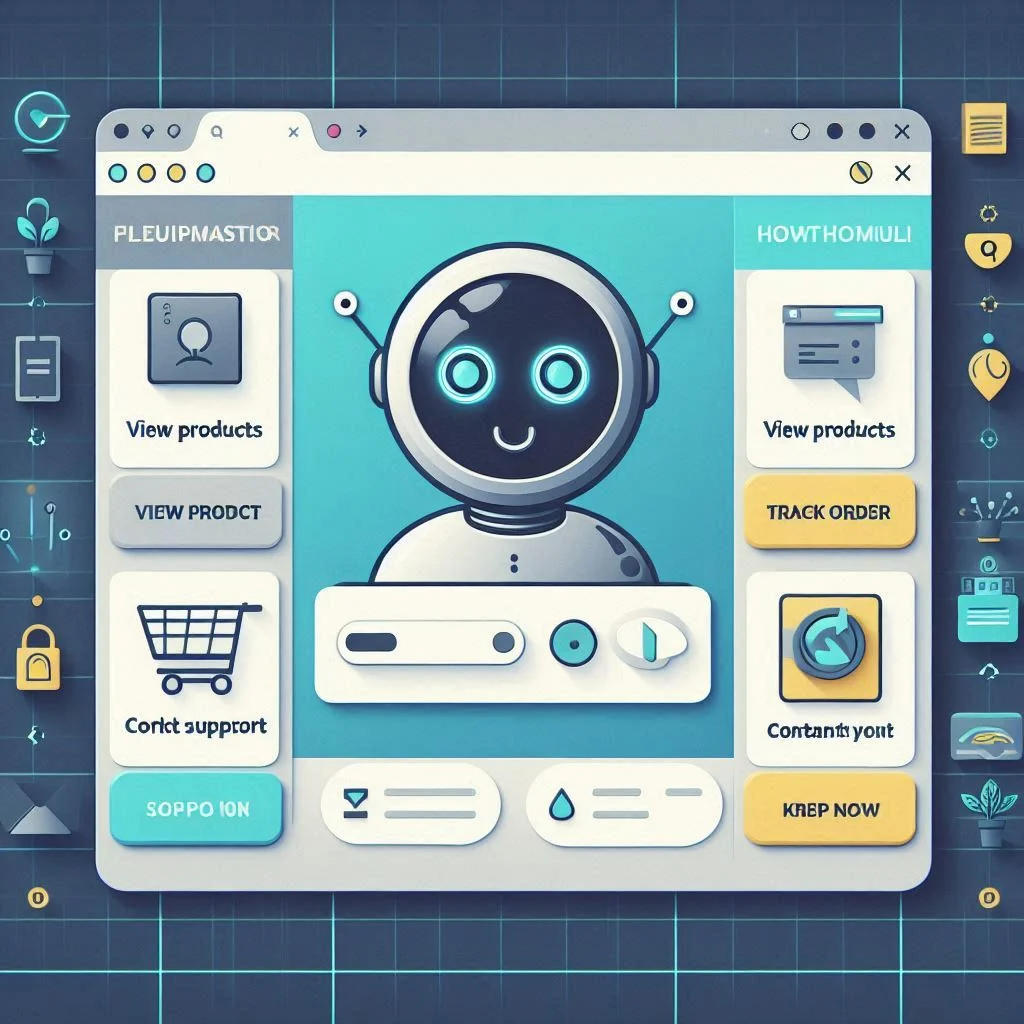
Rule-Based Chatbots
Rule-based chatbots rely on pre-set rules and conditions to provide responses. These bots follow a decision tree or a series of “if-then” statements to guide interactions. They are highly structured but cannot handle queries outside their programmed rules.
- Use Case: Automated responses for structured processes like booking systems.
- Advantages: Predictable and reliable within the defined scope.
- Limitations: Inability to adapt to dynamic conversations or learn over time.
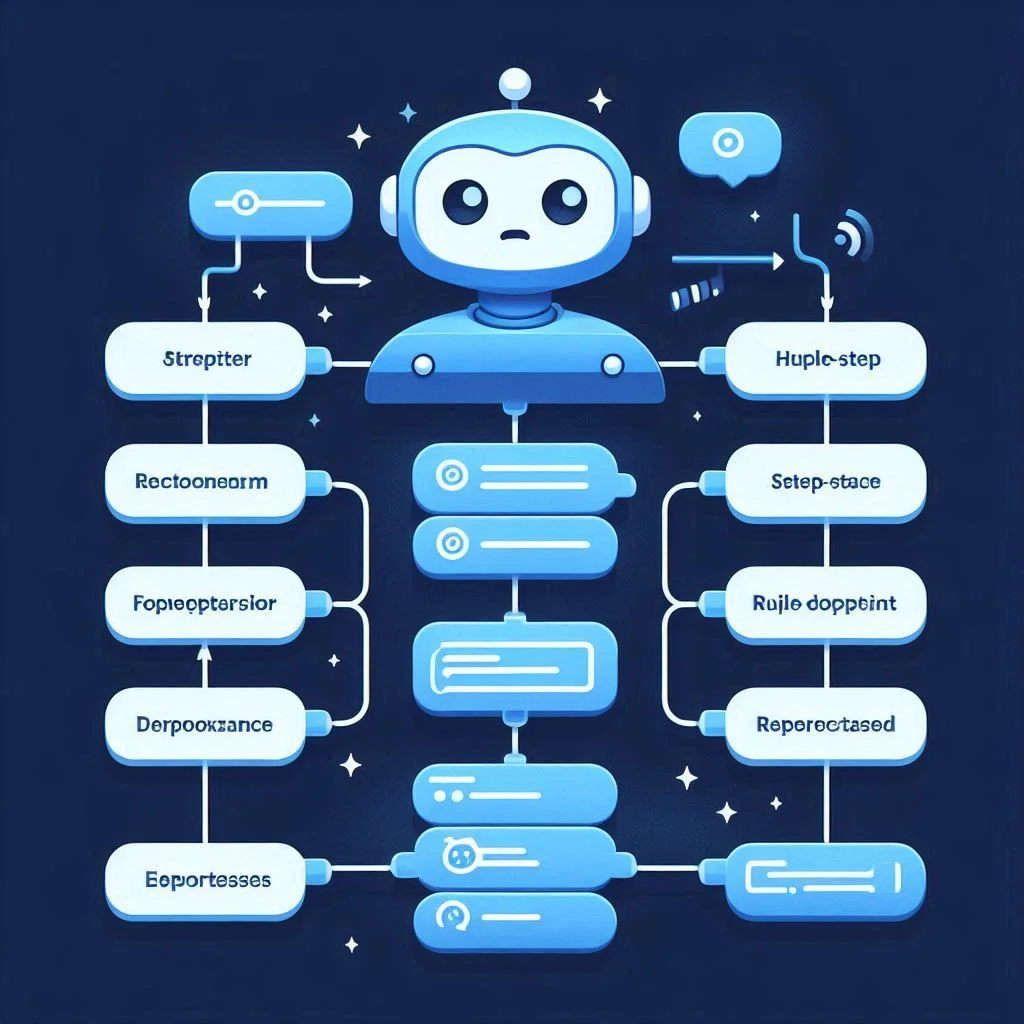
Keyword Recognition-Based Chatbots
These bots use keyword detection to match user input with predefined responses. By identifying keywords in the conversation, they attempt to provide relevant answers. While more flexible than rule-based bots, they may fail if keywords are missing or phrased differently.
- Use Case: Customer queries and basic troubleshooting.
- Advantages: Better flexibility than menu- or rule-based bots.
- Limitations: Limited contextual understanding and prone to errors.
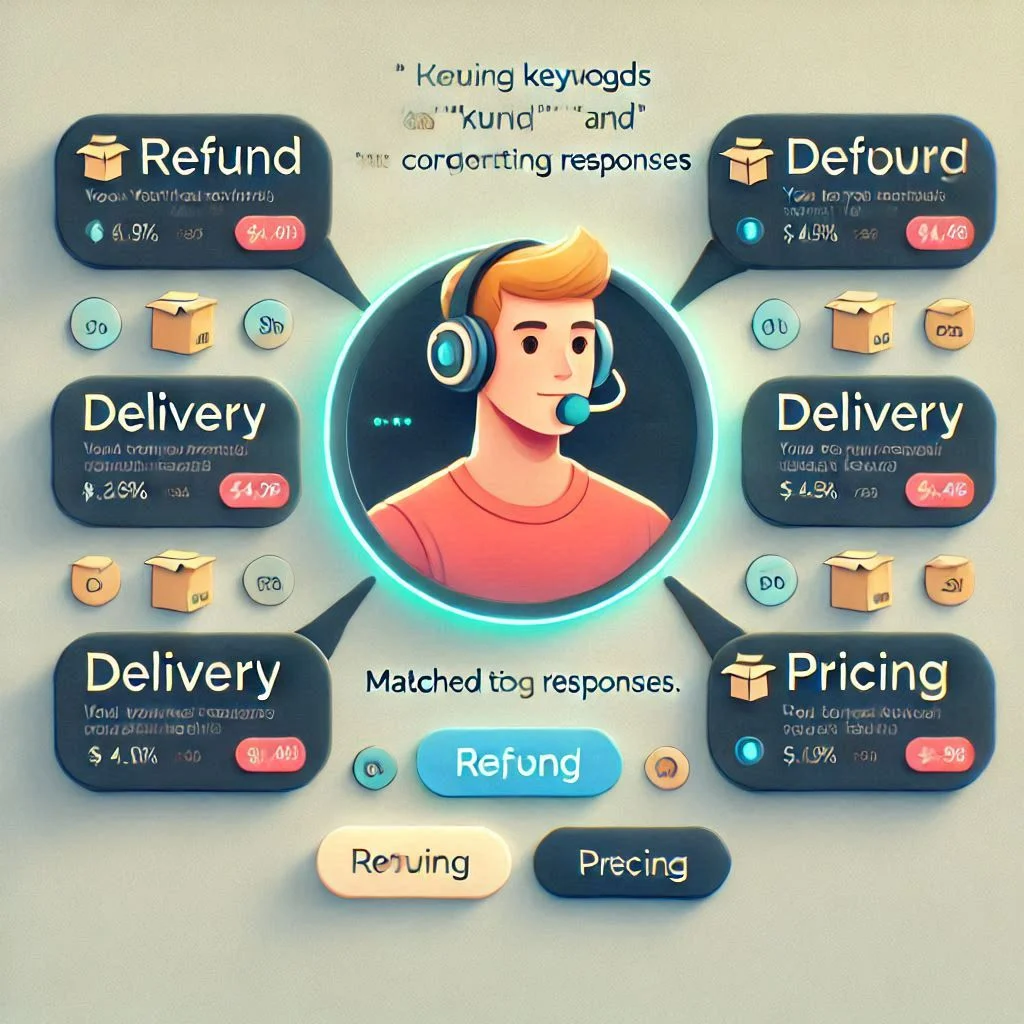
AI-Powered Chatbots (Contextual Chatbots)
AI-powered chatbots, also known as contextual chatbots, leverage machine learning and NLP to understand user intent and provide responses based on context. These bots continuously improve by learning from past interactions and can handle complex queries.
- Use Case: Personal assistants, customer support, and e-commerce recommendations.
- Advantages: Contextual understanding, adaptability, and personalization.
- Limitations: Requires training data and ongoing maintenance.
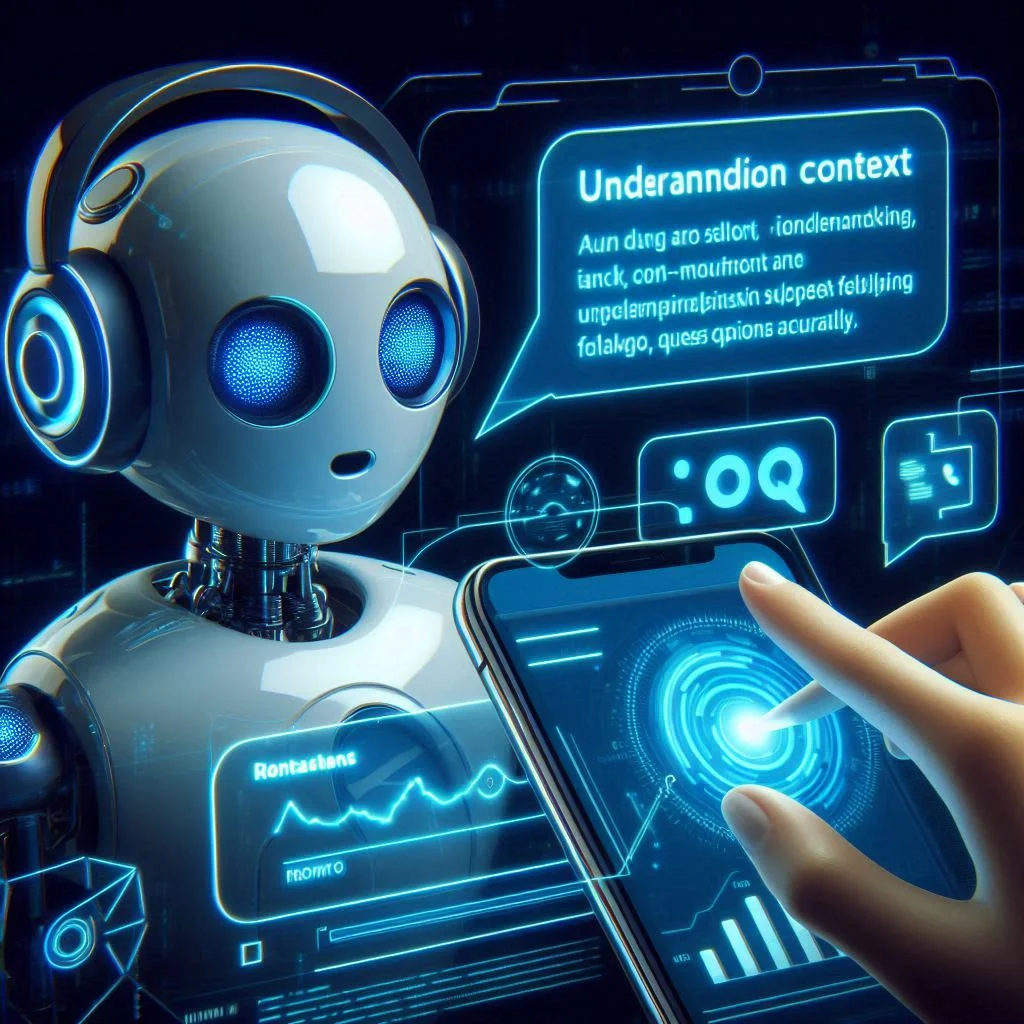
Voice-Based Chatbots
Voice-based chatbots use speech recognition and synthesis to engage users through voice interactions. These bots are widely used in smart devices and customer service phone systems.
- Use Case: Virtual assistants like Alexa or Google Assistant, and automated IVR systems.
- Advantages: Hands-free convenience and accessibility.
- Limitations: Challenges with accents, noise interference, and understanding complex commands.
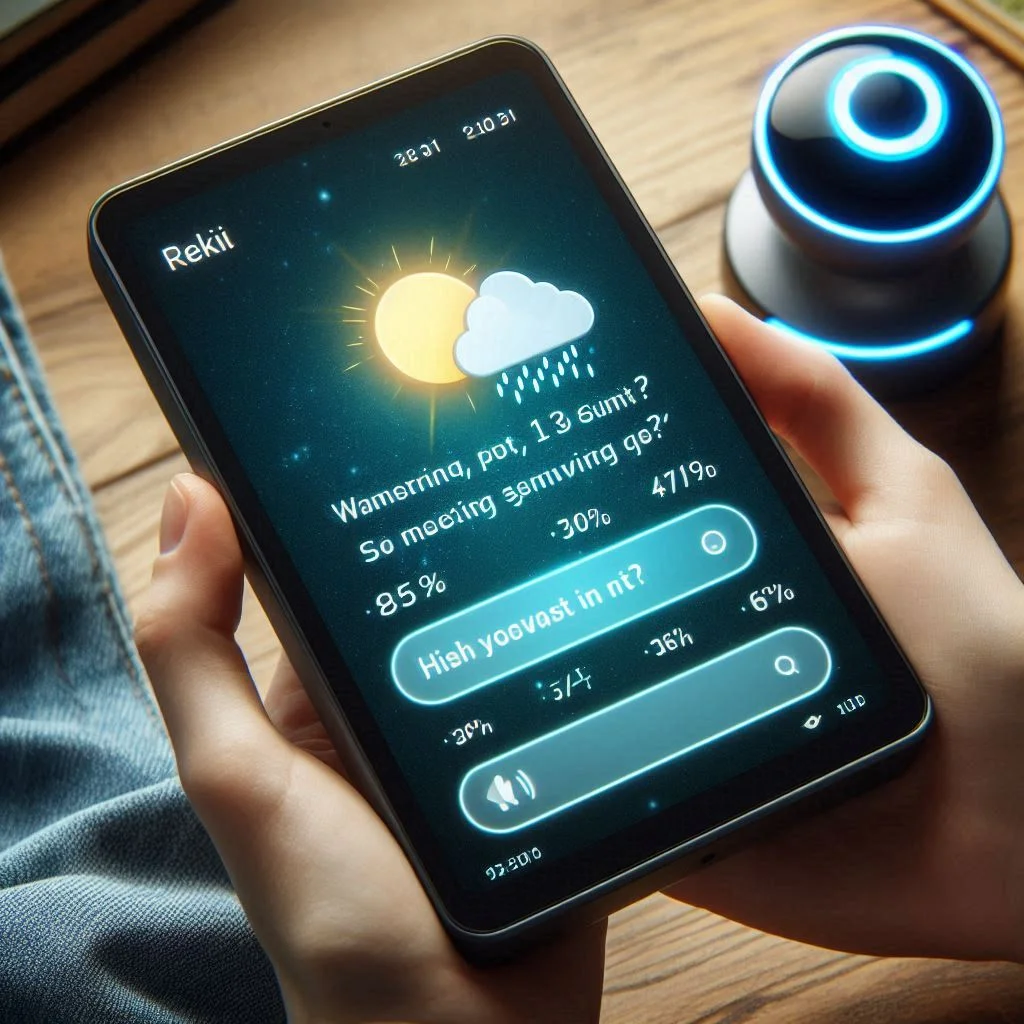
Generative AI Chatbots
Generative AI chatbots use advanced models like GPT to generate unique, human-like responses. Unlike other bots, they create responses dynamically rather than selecting from pre-programmed replies, making them ideal for creative and unstructured tasks.
- Use Case: Content creation, brainstorming, and advanced customer interactions.
- Advantages: High versatility and conversational depth.
- Limitations: Potential for incorrect or biased outputs.

Hybrid Chatbots
Hybrid chatbots combine rule-based and AI-powered approaches to provide both structure and flexibility. They use predefined rules for straightforward tasks while leveraging AI for complex queries.
- Use Case: Businesses needing a mix of structured and dynamic interactions.
- Advantages: Balanced performance and cost-effectiveness.
- Limitations: Requires careful integration of both components.
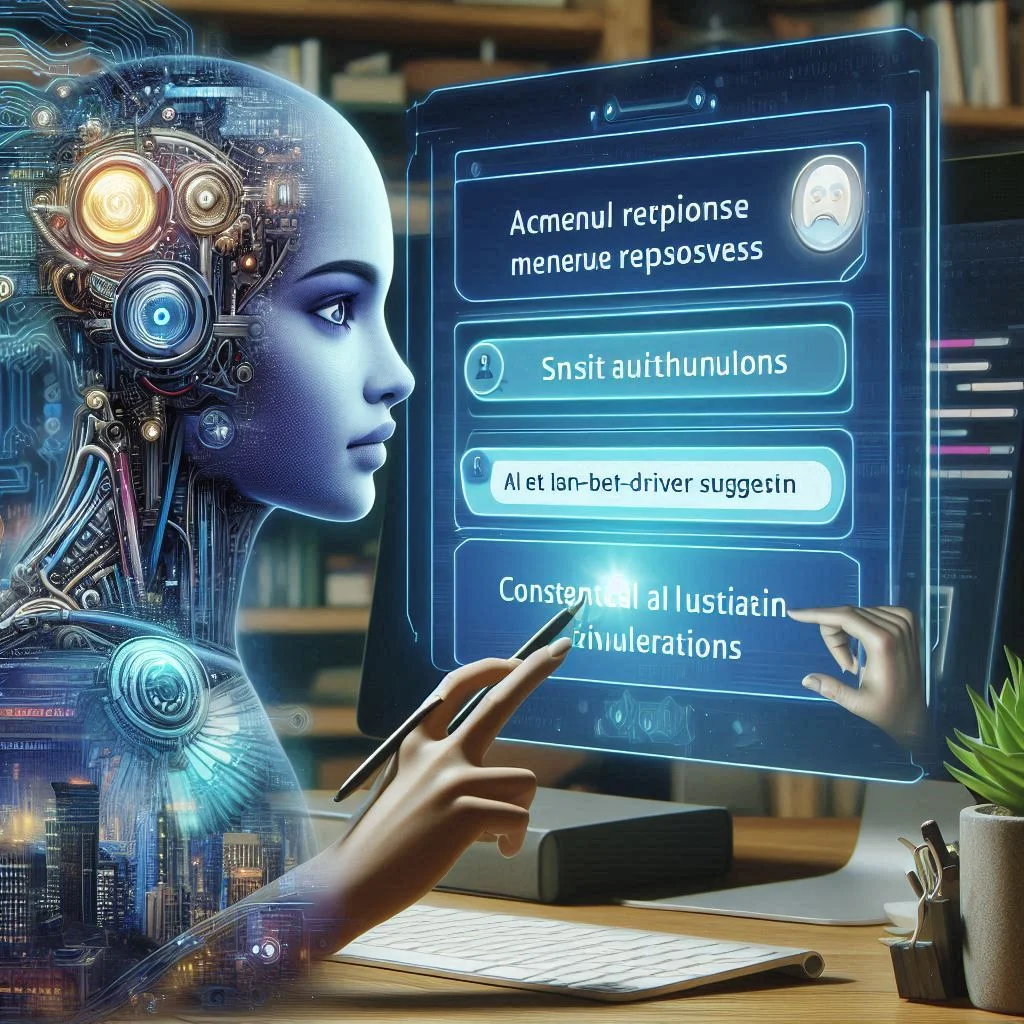
How AI Chatbots Differ from Traditional Ones
AI chatbots have revolutionized the way businesses interact with their customers, setting themselves apart from traditional chatbots in several key aspects. While traditional bots rely on rigid programming and limited functionality, AI chatbots bring intelligence, adaptability, and a human-like approach to conversations.
Understanding and Interaction
AI chatbots excel in their ability to understand and interpret user input beyond predefined rules. By utilizing natural language processing (NLP), these bots can comprehend context, detect sentiment, and process complex queries.
- AI Chatbots: Can handle multi-turn conversations, understand slang, and provide contextually accurate responses.
- Traditional Chatbots: Follow predefined scripts, offering limited responses to specific inputs.
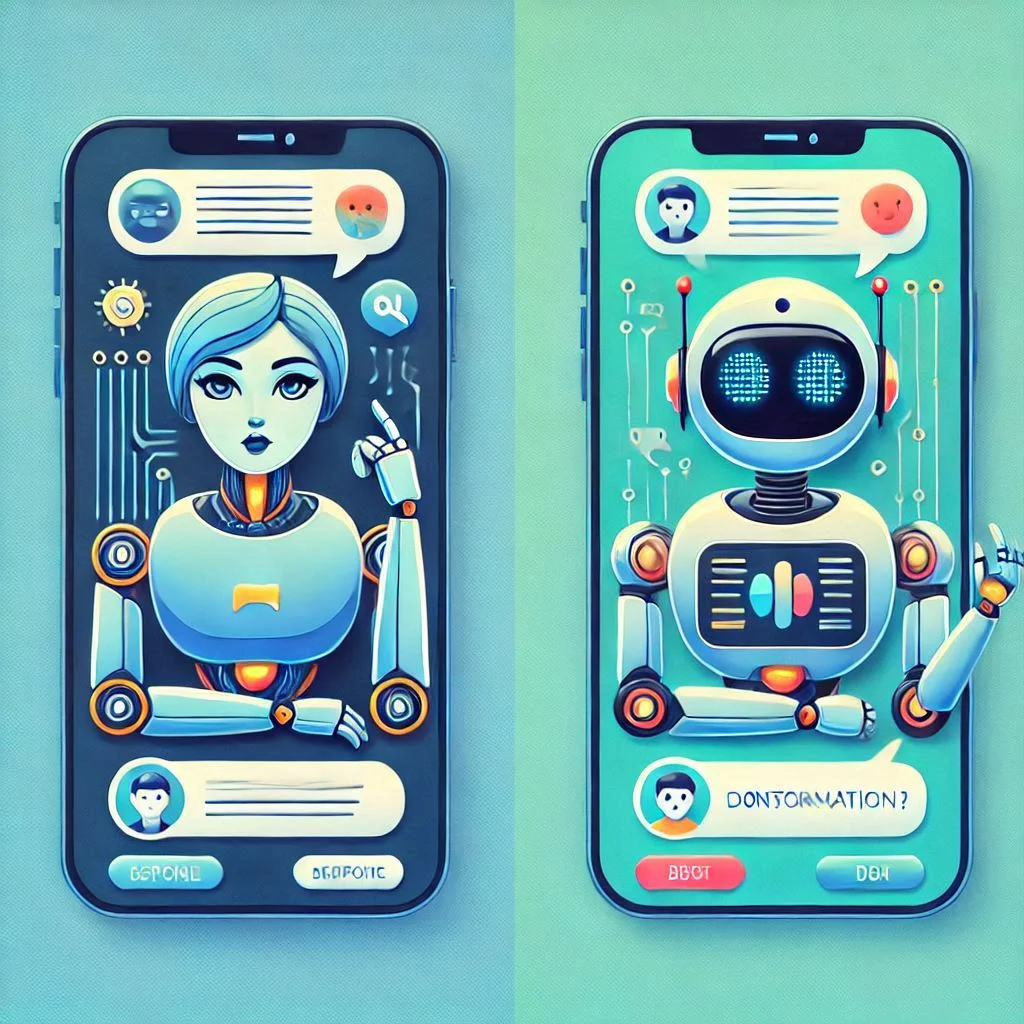
Learning and Adapting
AI chatbots have the unique ability to learn from past interactions and adapt to user preferences over time. Using machine learning (ML), they refine their responses and improve performance as they process more data.
- AI Chatbots: Continuously update their knowledge base, enabling better handling of future queries.
- Traditional Chatbots: Operate on static programming, requiring manual updates to expand capabilities.
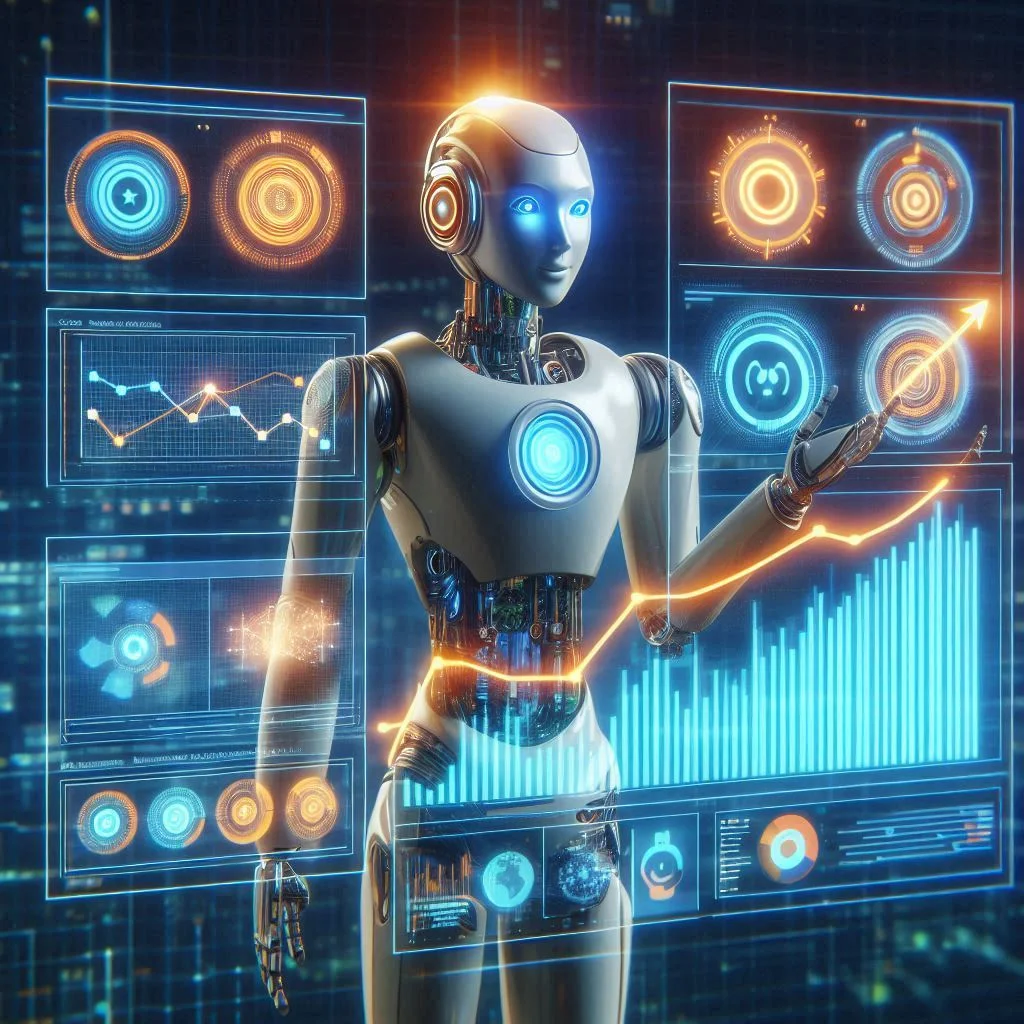
Memory and Personalization
AI chatbots can retain information about users, creating personalized experiences by remembering preferences, past interactions, and context. This enhances engagement and builds stronger customer relationships.
- AI Chatbots: Tailor responses based on user history, such as addressing preferences or providing relevant suggestions.
- Traditional Chatbots: Lack memory functionality, treating every interaction as isolated.
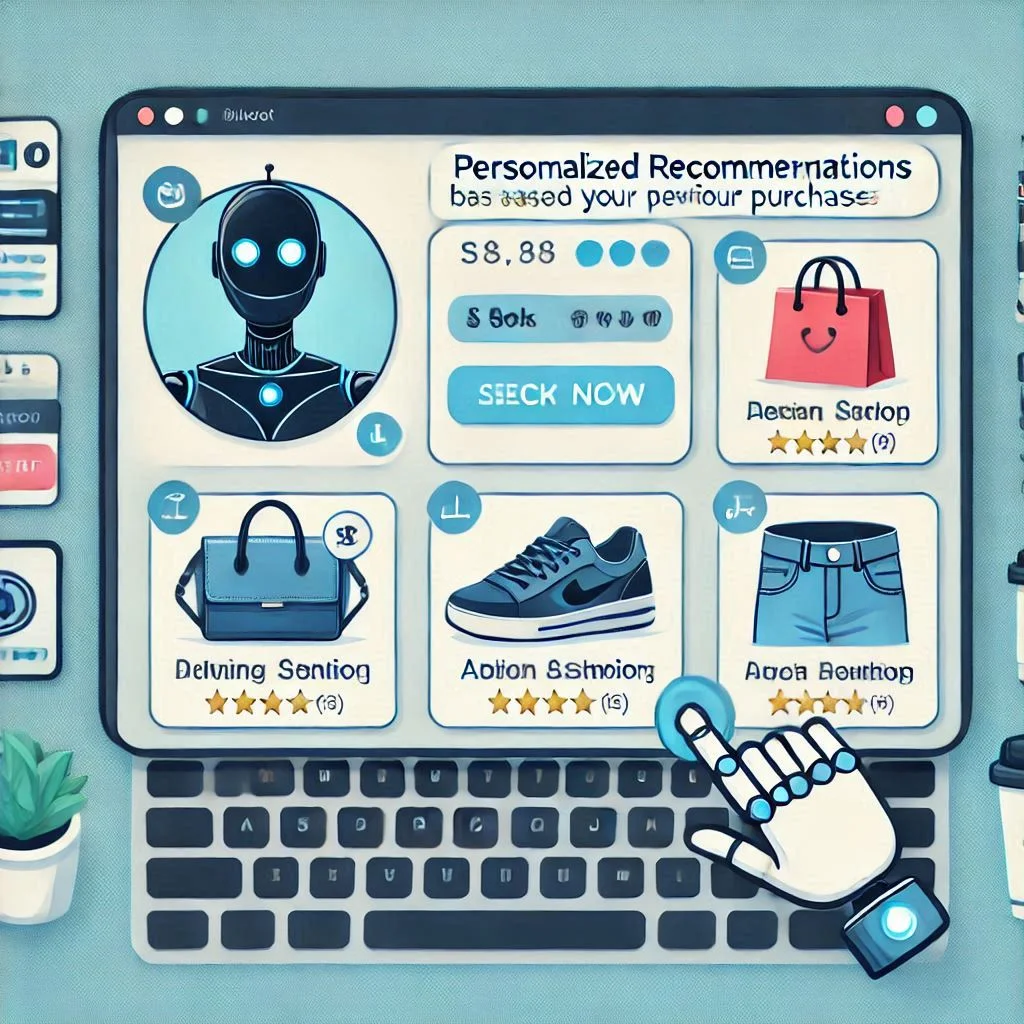
Generative Capabilities
AI-powered chatbots, especially those using generative AI models, can create unique and dynamic responses, making them suitable for creative or unstructured conversations. They move beyond simple retrieval-based mechanisms to generate new and contextually appropriate replies.
- AI Chatbots: Use models like GPT to provide creative, human-like responses, enhancing conversational quality.
- Traditional Chatbots: Limited to pre-programmed responses, unable to generate unique replies.

Steps to Create an AI Bot
Creating an AI bot involves a systematic approach to ensure it meets your business goals and delivers an exceptional user experience. Follow these steps to develop a robust, efficient, and scalable AI bot.
Step 1: Define Your Use Case
Start by identifying the primary purpose of your AI bot. Whether it’s customer support, sales, lead generation, or task automation, clearly defining the use case helps in setting the development direction.
- Key Considerations:
- Target audience and their needs.
- Problems your bot will solve.
- Key performance indicators (KPIs) to measure success.
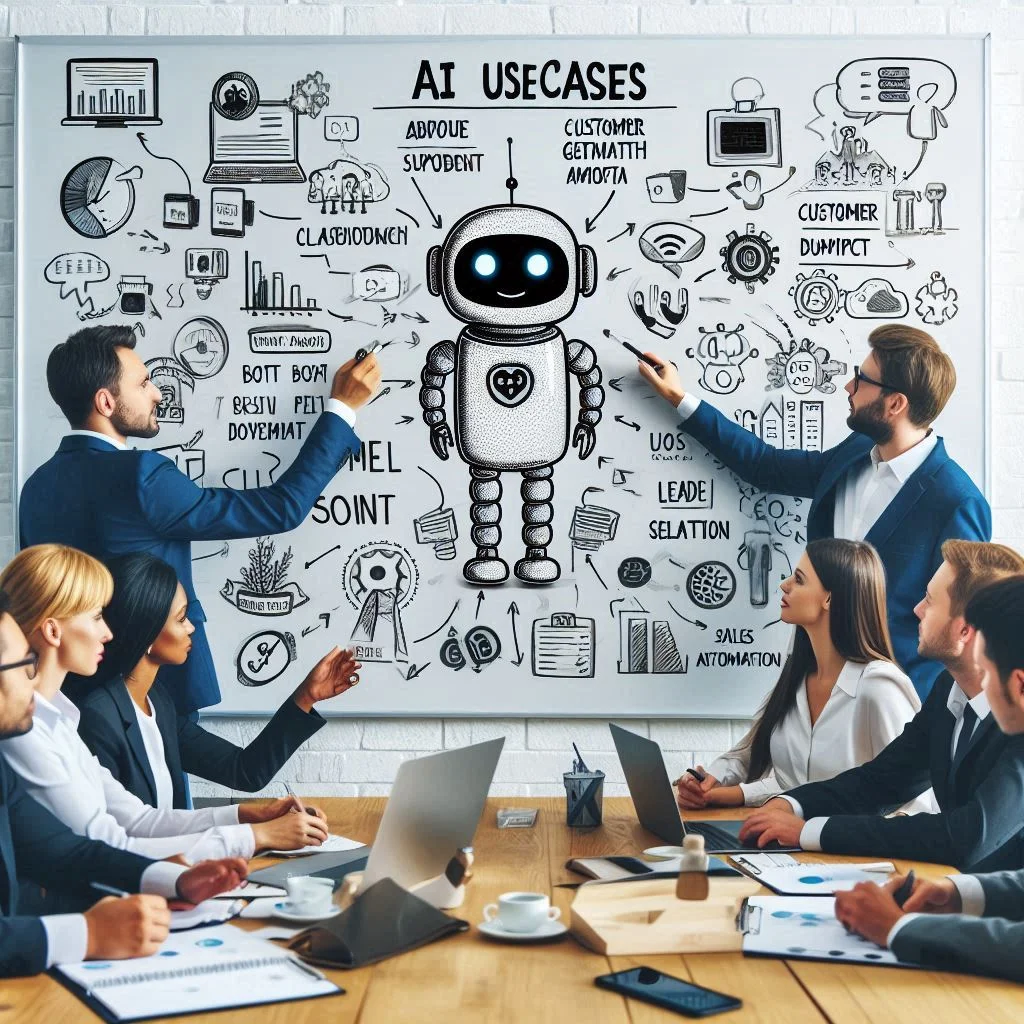
Step 2: Select the Right Channel for Your AI Bot
Choose where your AI bot will operate based on your audience. Popular channels include websites, mobile apps, messaging platforms like WhatsApp and Facebook Messenger, and voice assistants like Alexa.
- Factors to Consider:
- User preferences.
- Compatibility with the channel’s API.
- Ease of deployment and user accessibility.
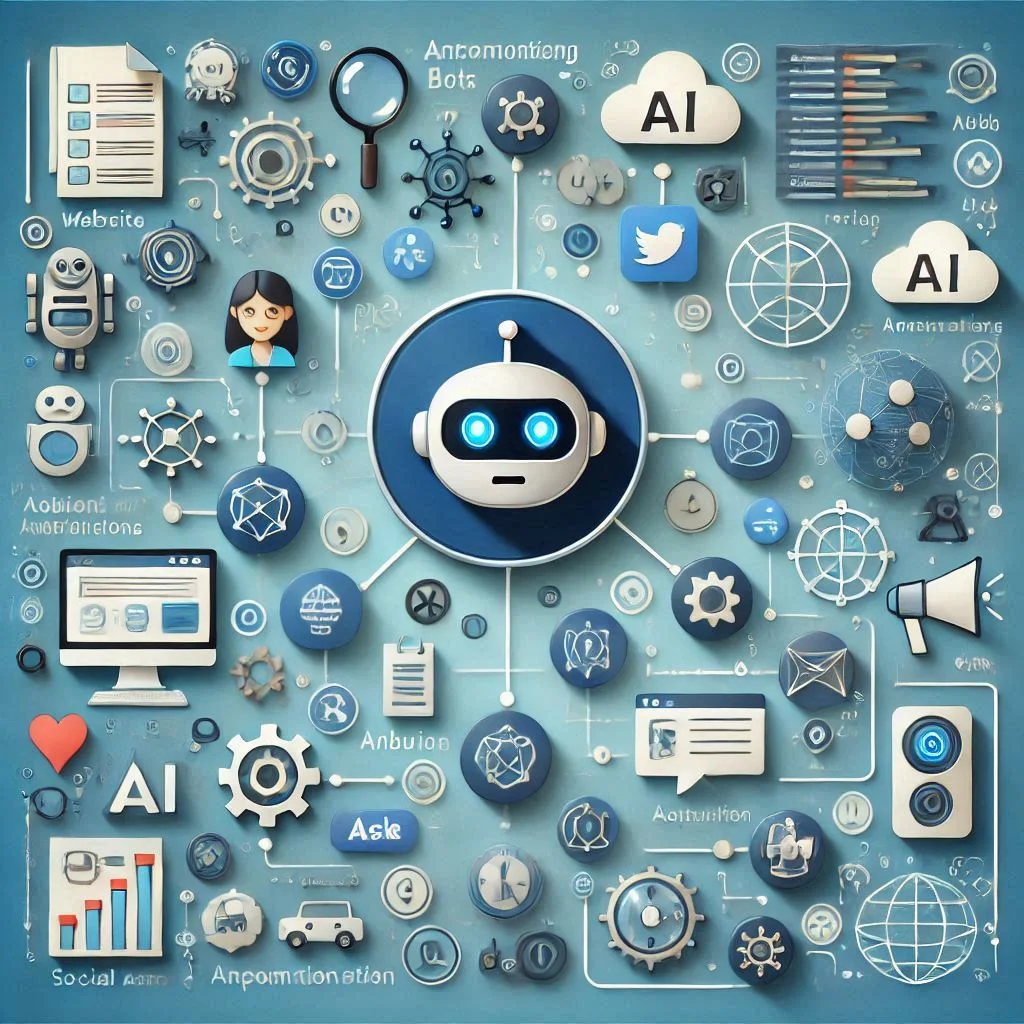
Step 3: Choose the Technology Stack
Selecting the right technology stack ensures your bot is equipped with the necessary tools to understand and respond effectively.
Natural Language Processing Tools
NLP tools like Google Dialogflow, IBM Watson, or Microsoft Azure Cognitive Services enable the bot to interpret user queries accurately.
Cloud Infrastructure
Leverage scalable cloud platforms like AWS, Google Cloud, or Microsoft Azure to host and manage your bot’s backend infrastructure.
AI/ML Software
Use AI frameworks like TensorFlow or PyTorch to integrate advanced machine learning models for your bot’s decision-making capabilities.
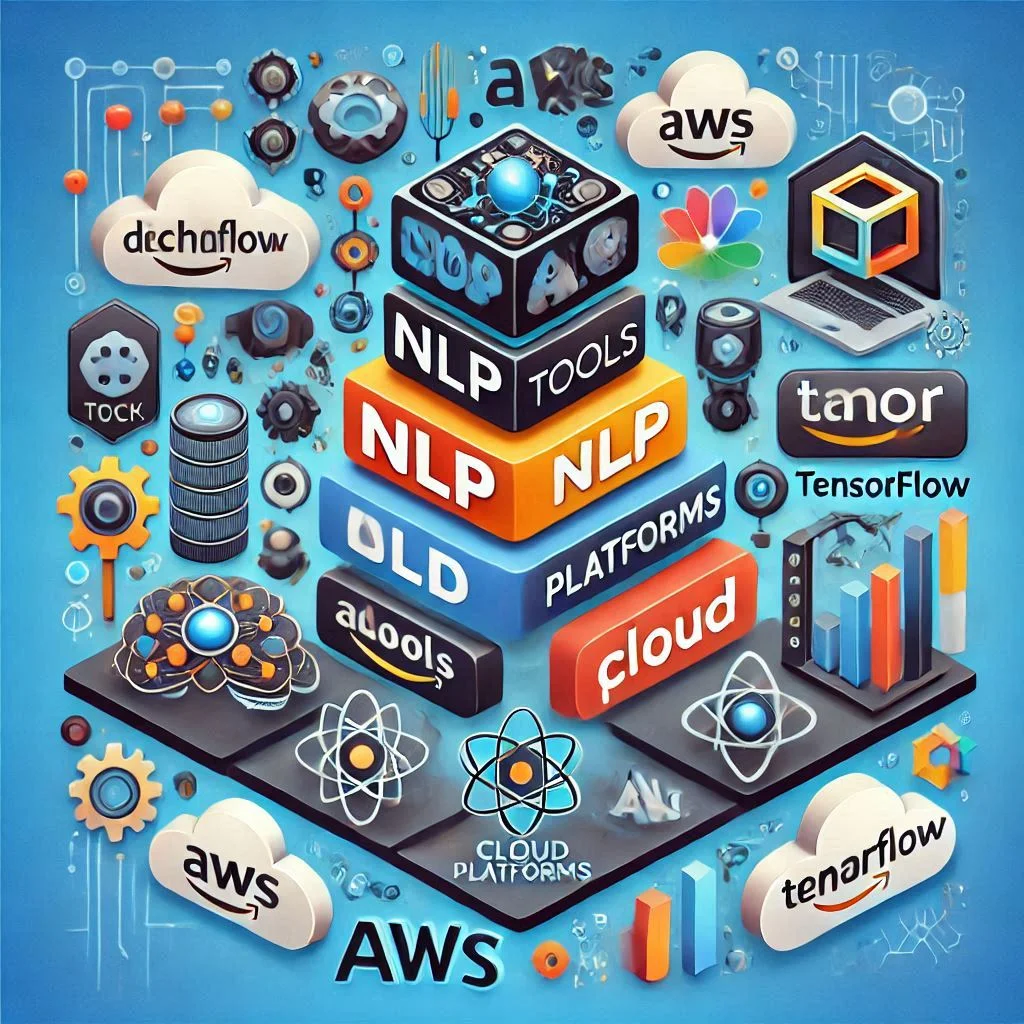
Step 4: Build a Knowledge Base
Develop a comprehensive knowledge base that includes FAQs, policies, product details, and any other information your bot might need to respond effectively.
- Best Practices:
- Use structured data formats like JSON or XML for efficient retrieval.
- Continuously update the knowledge base with new information.
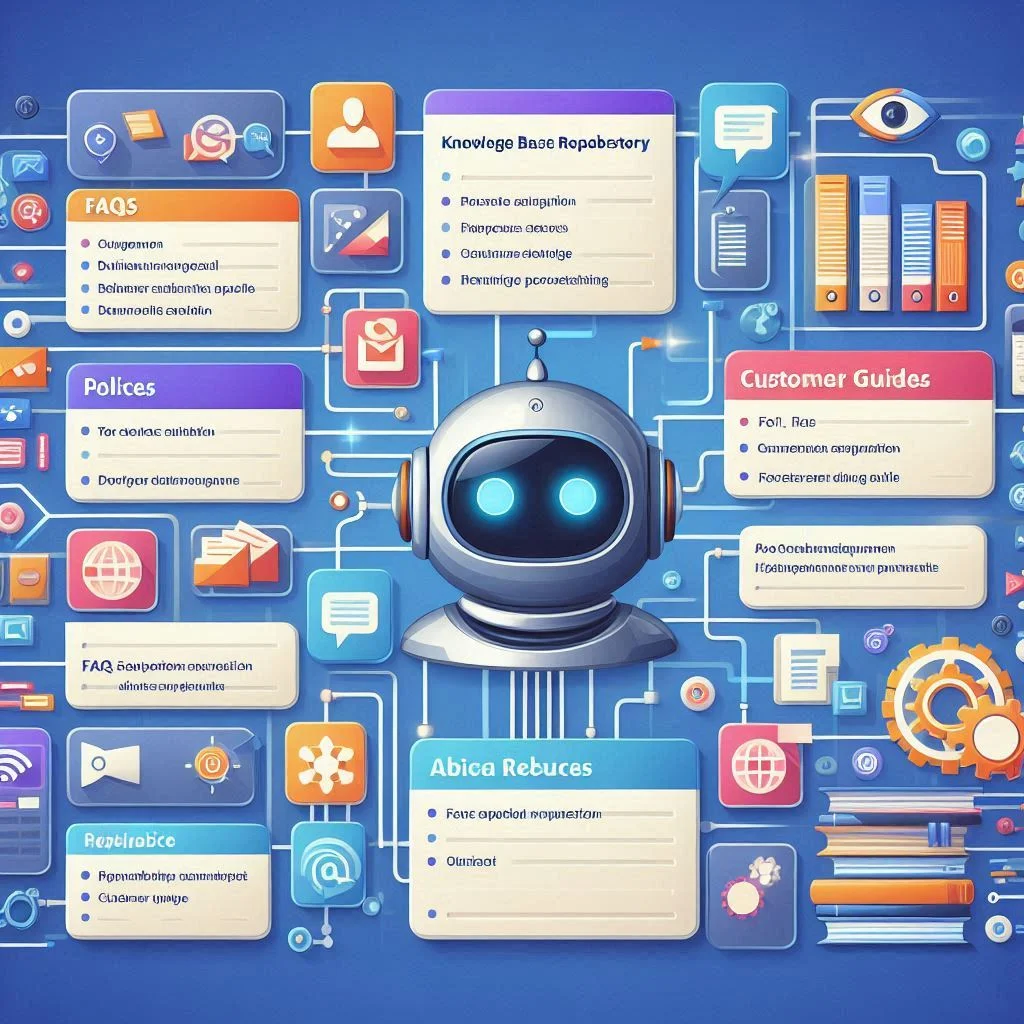
Step 5: Design the Conversation Flow
Create intuitive and user-friendly conversation flows to ensure seamless interaction. Use decision trees and scenario mapping to outline possible user queries and corresponding bot responses.
- Tips:
- Incorporate fallback responses for unrecognized queries.
- Use natural language for responses to keep interactions engaging.

Step 6: Integrate and Test Your AI Bot
Integration and testing are crucial to ensure your bot performs efficiently in real-world scenarios.
Infrastructure Integration
Connect your AI bot to existing systems like CRM, ERP, or databases for seamless data exchange.
User Interface Integration
Ensure your bot’s interface aligns with your brand identity and provides an intuitive experience.
Testing and Validation
Perform extensive testing using real-world scenarios to validate your bot’s accuracy and performance.
Deployment
Launch the bot on the chosen channel while ensuring it can handle real-time interactions seamlessly.
Security and Compliance
Implement data encryption, authentication mechanisms, and GDPR compliance to protect user data.
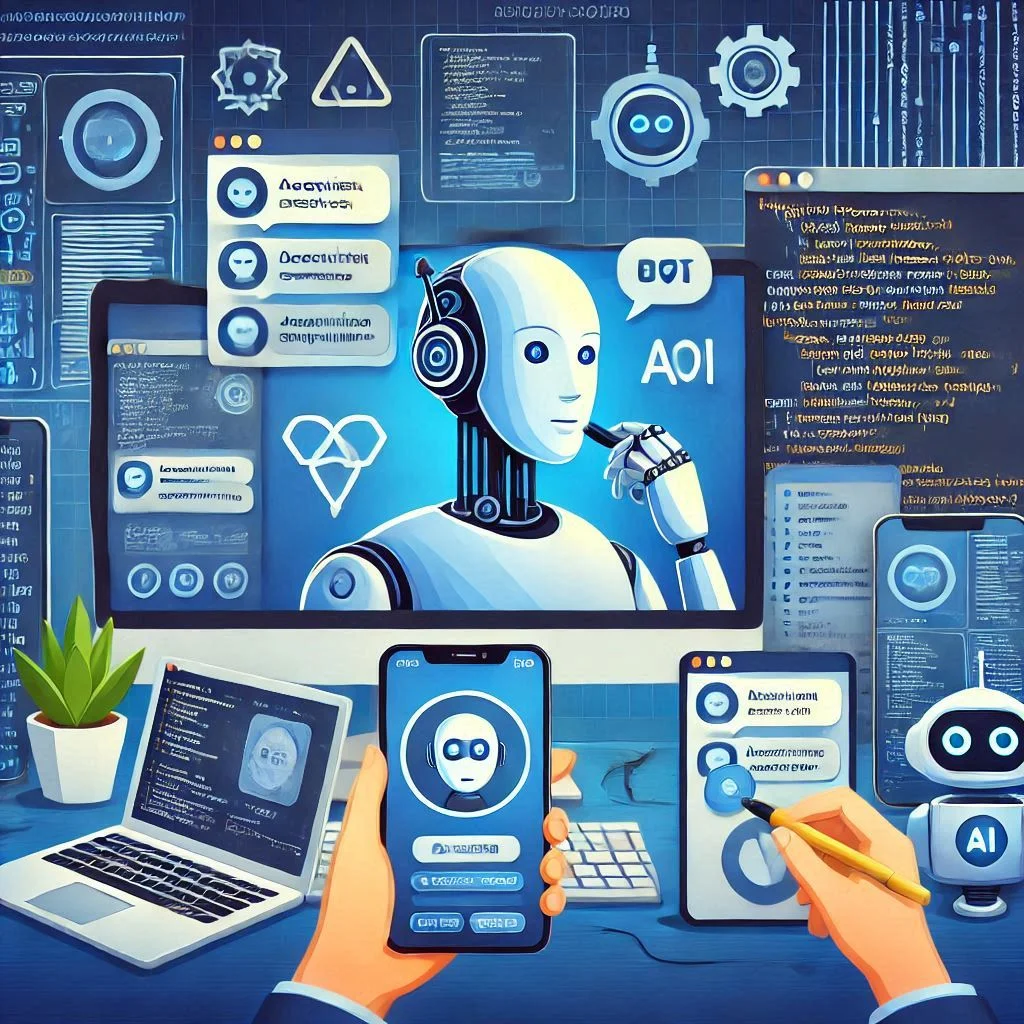
Step 7: Launch and Monitor Your AI Bot
After deployment, monitor your bot’s performance using analytics tools. Track metrics like user engagement, accuracy rate, and response time to make continuous improvements.
- Key Steps:
- Use feedback loops to refine bot responses.
- Regularly update the bot with new features and information.
- Monitor downtime and resolve technical issues promptly.
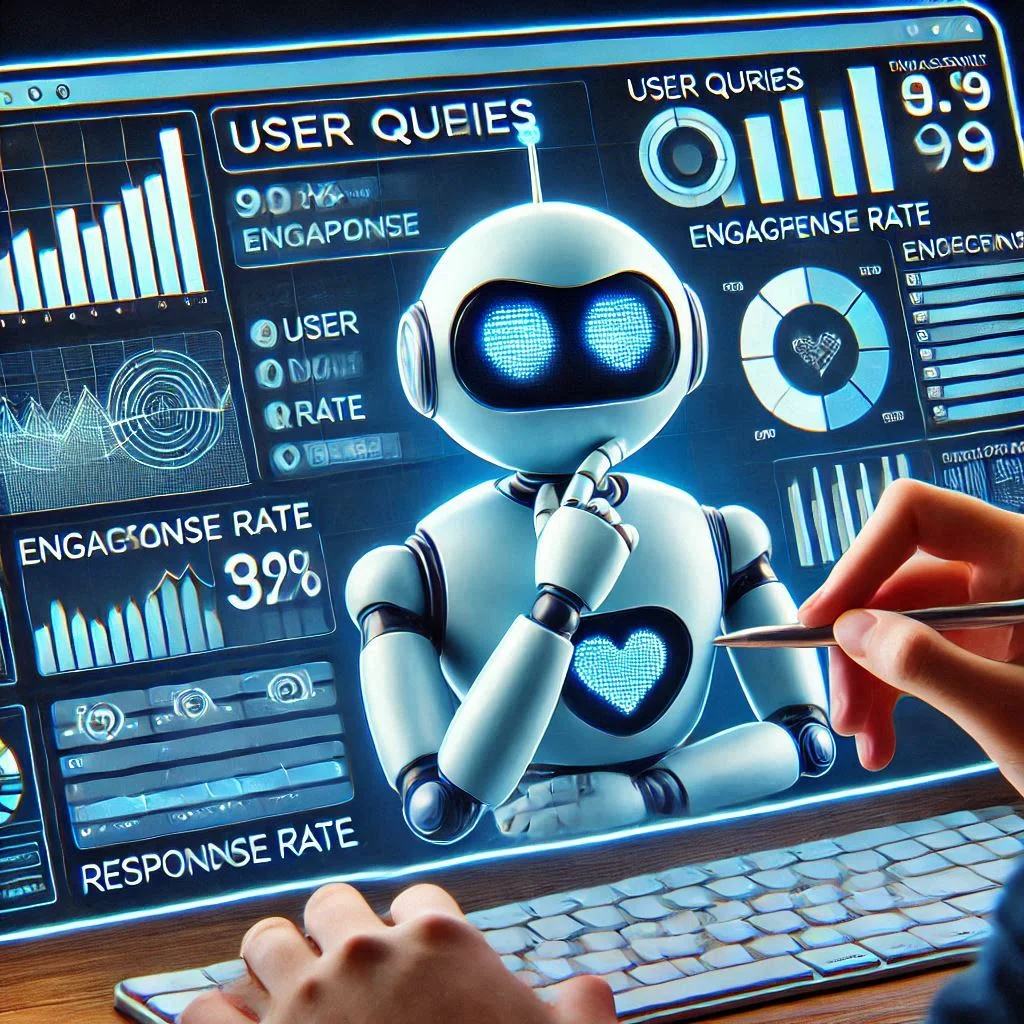
Pre-Built AI Chatbot Builders vs. Custom AI Bots
Choosing between pre-built AI chatbot builders and custom AI bots depends on your business requirements, technical expertise, and budget. Here’s a detailed comparison to help you decide the best option.
AI Chatbot Builders
AI chatbot builders are ready-to-use platforms that allow businesses to create bots without extensive coding knowledge. These tools are designed for quick deployment and ease of use.
Pros of AI Chatbot Builders
- Ease of Use:
- No coding knowledge is required. Most platforms provide drag-and-drop interfaces for bot creation.
- Suitable for small businesses or those without technical teams.
- Quick Deployment:
- Bots can be designed and launched in a matter of hours or days.
- Ideal for time-sensitive projects.
- Cost-Effective:
- Affordable subscription-based pricing models.
- Reduces the need for hiring dedicated developers.
- Integrated Features:
- Comes with built-in analytics, templates, and multi-channel support.
- Includes pre-trained Natural Language Processing (NLP) models for improved interactions.
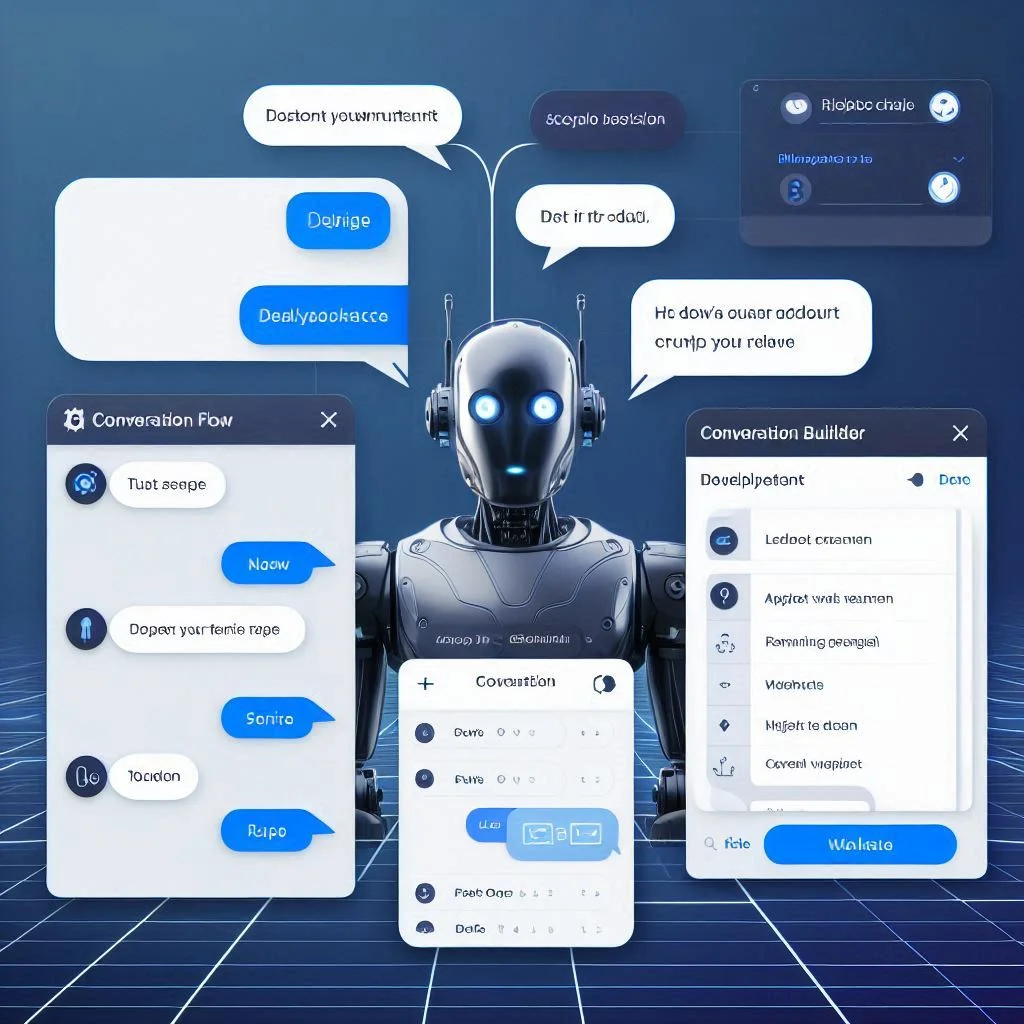
Cons of AI Chatbot Builders
- Limited Customization:
- Templates and functionalities might not fully meet specific business needs.
- Restricted ability to modify or add advanced features.
- Dependency on Providers:
- Business operations depend on the reliability of the third-party platform.
- Migration to another platform can be challenging.
- Scalability Issues:
- May not handle high traffic or complex queries effectively.
- Limited flexibility in integrating with advanced systems.
- Data Privacy Concerns:
- User data is stored on third-party servers, raising potential compliance issues.

Building a Custom AI Chatbot
Custom AI chatbots are tailored solutions developed from scratch, and designed to meet specific business requirements. They provide unmatched flexibility and scalability but require more time and resources.
Pros of Custom AI Bots
- Complete Customization:
- Fully tailored to your business’s unique needs.
- Offers control over every aspect, from design to backend integrations.
- Advanced Features:
- Allows integration of cutting-edge technologies like sentiment analysis, deep learning, and multi-language capabilities.
- Handles complex workflows efficiently.
- Enhanced Data Security:
- Data is stored and managed in your own infrastructure, ensuring compliance with data privacy regulations.
- Scalability:
- Can handle a growing user base and complex interactions without performance degradation.

Cons of Custom AI Bots
- High Initial Investment:
- Requires substantial resources, including hiring developers or outsourcing to experts.
- Higher upfront costs compared to pre-built solutions.
- Longer Development Time:
- Designing and building from scratch can take weeks or months, depending on the complexity.
- Maintenance Requirements:
- Ongoing technical support and updates are necessary to ensure smooth operations.
- Requires a dedicated team for troubleshooting and scalability management.
- Complexity:
- Development involves selecting and managing various tools and frameworks, requiring technical expertise.

Steps to Create an AI Bot
Creating an AI bot involves several steps, from planning to deployment. Here’s a roadmap:
Step 1: Define Your Use Case
Identify the problem your bot will solve, whether it’s customer support, lead generation, or internal automation.
Step 2: Select the Right Channel for Your AI Bot
Decide where your bot will operate—your website, messaging apps, or voice platforms.
Step 3: Choose the Technology Stack
Natural Language Processing Tools
Use NLP tools like Dialogflow or IBM Watson to process and understand user inputs.
Cloud Infrastructure
Leverage platforms like AWS or Google Cloud for scalable and secure hosting.
AI/ML Software
Incorporate machine learning tools to enhance the bot’s intelligence.
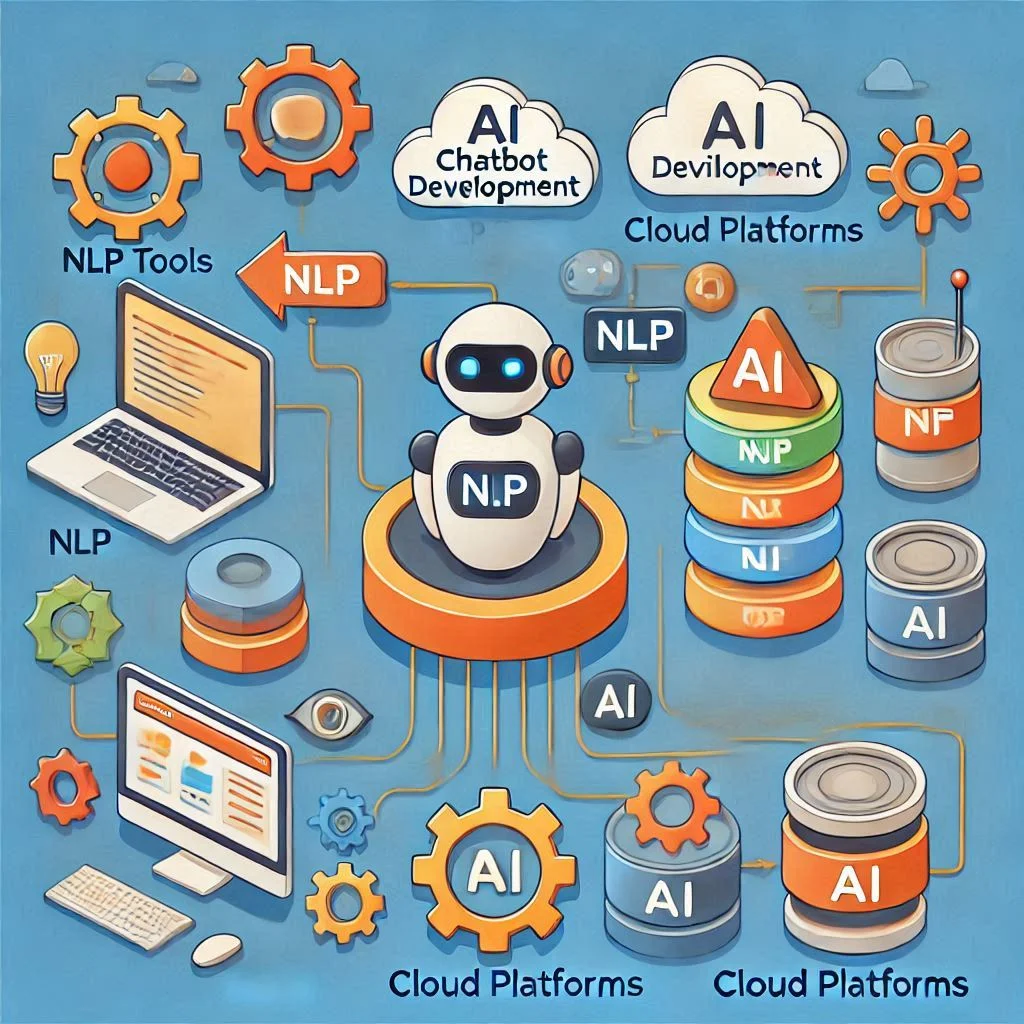
Step 4: Build a Knowledge Base
Create a comprehensive database of information that your chatbot can access to answer queries accurately.
Step 5: Design the Conversation Flow
Map out potential interactions to ensure smooth and intuitive conversations.
Step 6: Integrate and Test Your AI Bot
Infrastructure Integration
Ensure your bot integrates seamlessly with existing systems.
User Interface Integration
Develop an intuitive interface for user interactions.
Testing and Validation
Run extensive tests to identify and fix bugs.
Deployment
Deploy the bot on your chosen platform.
Security and Compliance
Implement robust measures to protect user data.
Step 7: Launch and Monitor Your AI Bot
After launching, continuously monitor the bot’s performance and refine it based on user feedback.
AI Chatbot Market and Real-Life Applications
Market Overview
The global AI chatbot market is expanding rapidly, driven by the demand for automated customer service and operational efficiency.
Popular Use Cases of AI Chatbots
Healthcare
Providing patient support, appointment scheduling, and medical advice.
Retail
Enhancing shopping experiences through personalized recommendations.
Finance
Assisting with banking inquiries and fraud detection.
Media and Entertainment
Engaging users with content recommendations and interactive storytelling.
Travel and Tourism
Managing bookings, itineraries, and real-time travel updates.
E-commerce
Streamlining customer support and boosting sales conversions.
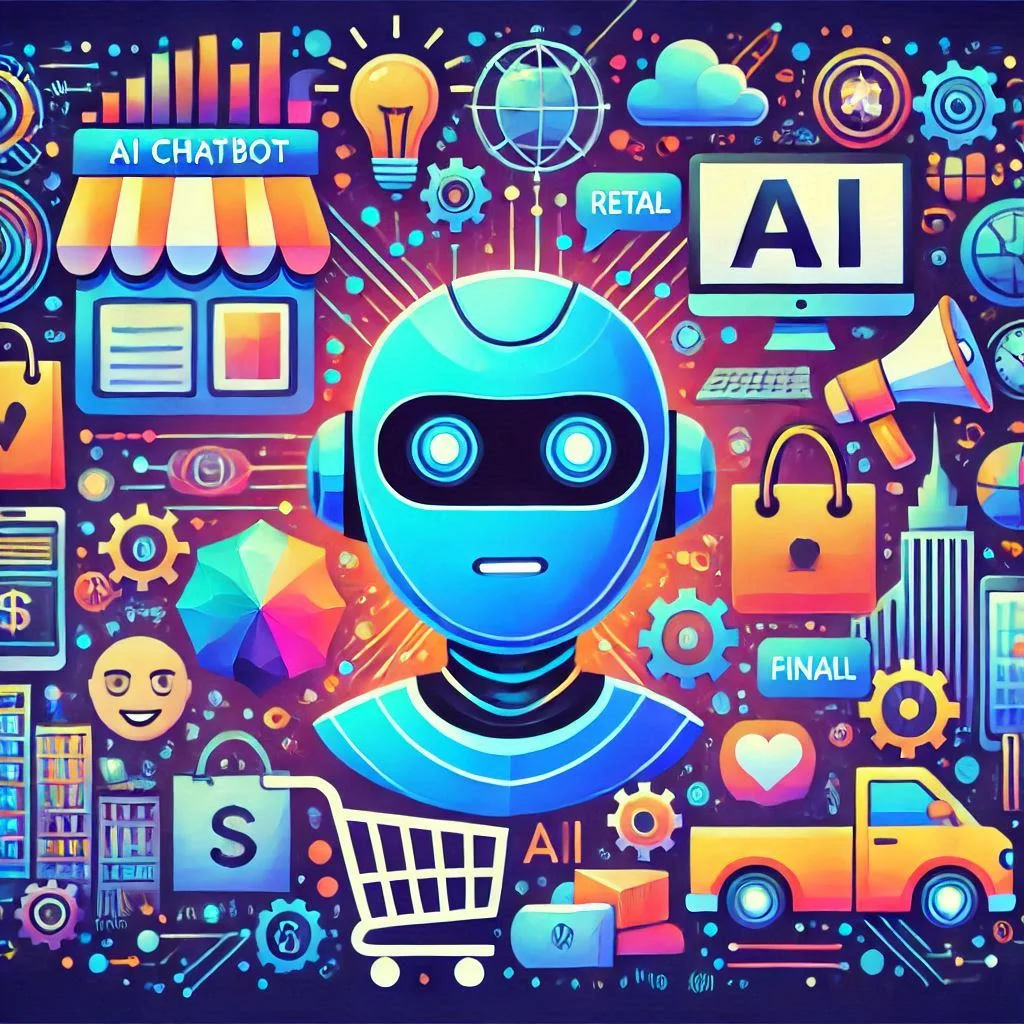
Benefits of AI Chatbots for Businesses
Instant 24/7 Response
AI chatbots operate around the clock, providing immediate assistance to users regardless of time zones. This ensures customers receive real-time support without having to wait for human agents, enhancing customer satisfaction and trust.
- Example Use Case: E-commerce websites use AI chatbots to handle queries about product availability, returns, and order tracking 24/7.
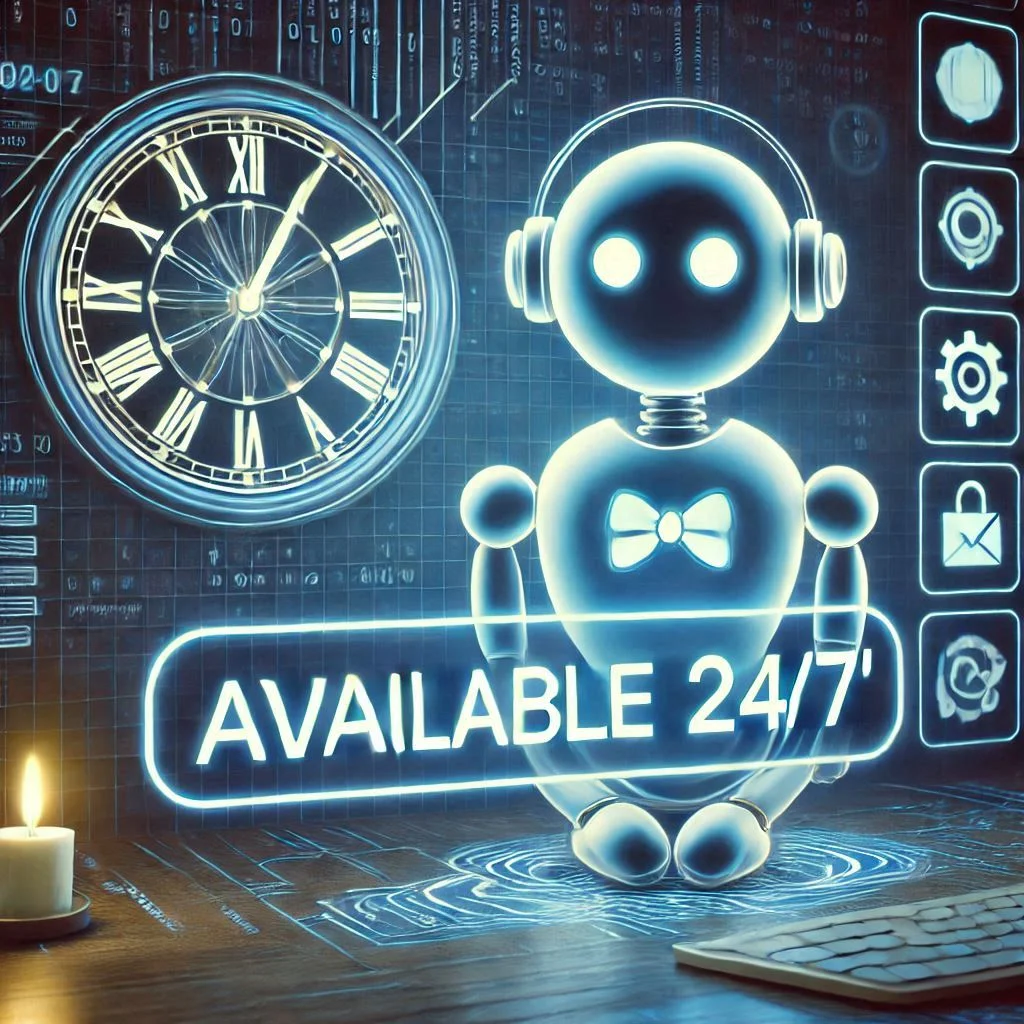
Personalized Engagement
AI chatbots utilize customer data to deliver tailored experiences. By analyzing user preferences, behaviors, and past interactions, they can offer personalized recommendations and services.
- Example Use Case: A travel agency chatbot suggests destinations based on previous bookings and user preferences.
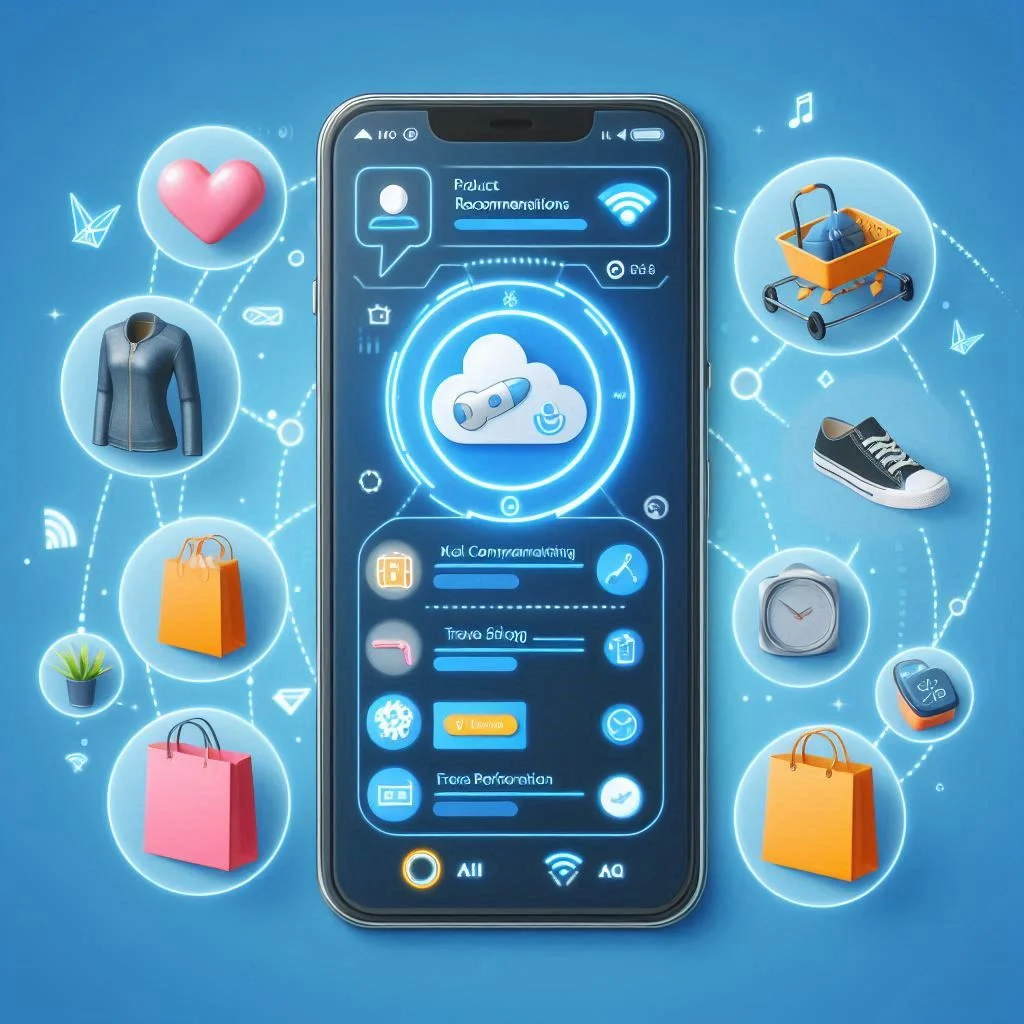
Simplified Processes
AI chatbots streamline complex workflows by automating repetitive tasks and guiding users through multi-step processes. Whether booking appointments or onboarding new customers, chatbots make the process simple and efficient.
- Example Use Case: Healthcare chatbots assist patients in booking appointments and filling out medical forms.
Multilingual Capabilities
AI chatbots are equipped to handle conversations in multiple languages, breaking language barriers and expanding the reach of businesses to a global audience.
- Example Use Case: A global e-commerce platform uses multilingual bots to support customers in different countries.
Automation of Routine Inquiries
Routine questions like “What are your store hours?” or “Where is my order?” can be handled effortlessly by chatbots, freeing up human agents to focus on more complex issues.
- Example Use Case: Retail chatbots address FAQs about store policies, product availability, and returns.
Cost and Time Efficiency
AI chatbots reduce the need for extensive customer service teams, saving businesses significant costs on hiring and training. They also shorten response times, enabling quicker resolutions.
- Example Use Case: A SaaS company reduces customer service costs by implementing an AI chatbot for tier-one support.
Enhanced Interactions and Conversions
By engaging users through interactive and conversational methods, AI chatbots improve user experiences and drive conversions. They guide customers through purchasing decisions and provide upselling opportunities.
- Example Use Case: An e-commerce chatbot recommends additional products based on the items in a user’s cart.
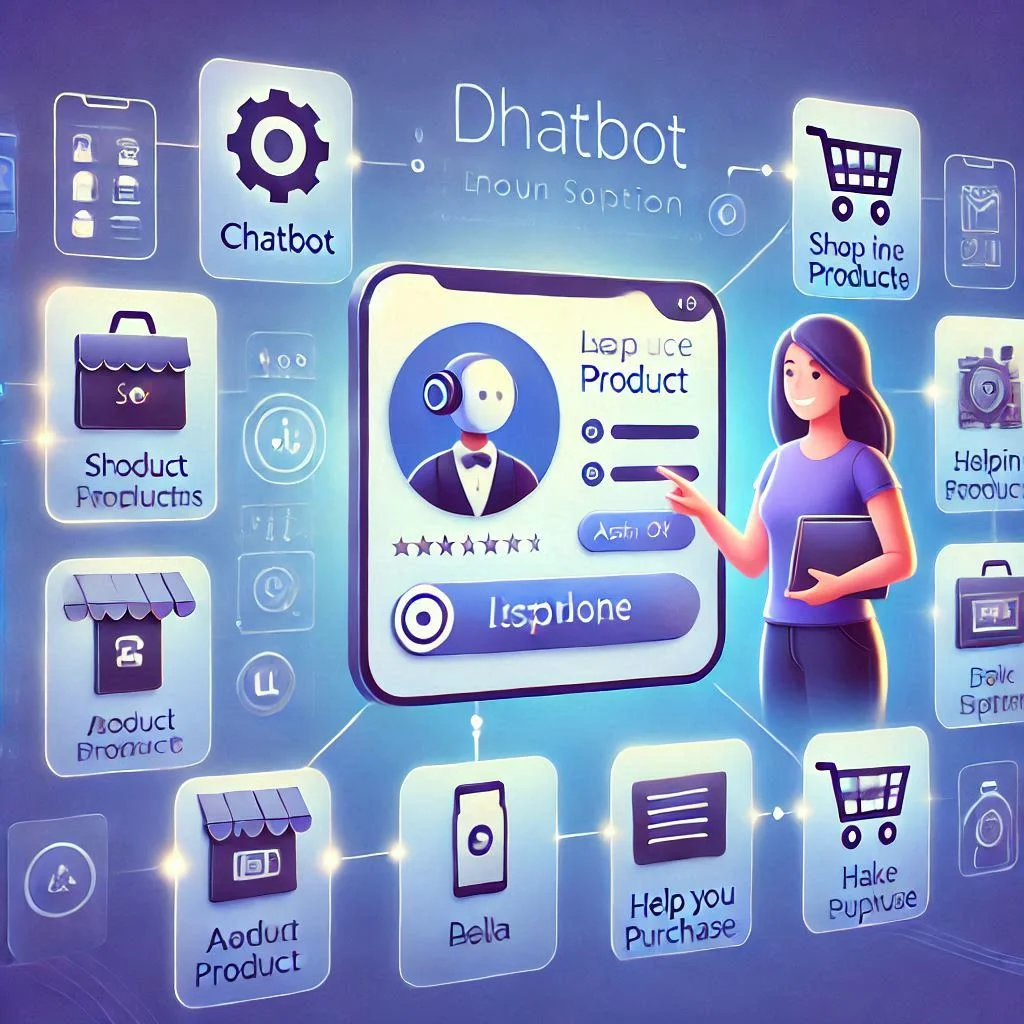
Customer Data Collection
AI chatbots gather valuable customer insights through interactions, including preferences, pain points, and frequently asked questions. This data can inform marketing strategies and product development.
- Example Use Case: A restaurant’s chatbot collects feedback from customers about menu preferences and dining experiences.
Improved Session Duration
AI chatbots keep users engaged by providing meaningful interactions, and increasing session durations on websites and apps. This positively impacts metrics like bounce rates and SEO rankings.
- Example Use Case: A media company uses chatbots to recommend articles, videos, and content based on user interests.
Superior Customer Experience
AI chatbots enhance customer satisfaction by delivering quick, consistent, and reliable interactions. They ensure customers leave with positive impressions of your brand.
- Example Use Case: An online banking chatbot resolves user queries quickly, creating a seamless customer experience.
Anonymity
Chatbots provide a safe space for users to ask questions or discuss concerns without fear of judgment. This is especially valuable in sensitive industries like healthcare and mental health.
- Example Use Case: A mental health chatbot allows users to discuss emotional well-being anonymously.
Costs and Tips for Creating an AI Bot
How Much Does It Cost to Build an AI Bot?
The cost of building an AI bot varies significantly based on complexity, functionality, and platform requirements. Here’s a detailed breakdown:
1. Basic AI Chatbot
- Cost Estimate: $5,000–$15,000
- Features: Simple rule-based systems with limited functionalities, suitable for handling FAQs or basic customer interactions.
- Ideal For: Small businesses and startups needing quick deployment.
2. Advanced AI Chatbot
- Cost Estimate: $20,000–$80,000
- Features: Incorporates natural language processing (NLP), integrations with third-party tools, and personalization capabilities.
- Ideal For: Medium-sized enterprises seeking enhanced user engagement.
3. Enterprise-Level AI Chatbot
- Cost Estimate: $100,000–$500,000+
- Features: High scalability, multilingual capabilities, advanced machine learning models, and real-time analytics.
- Ideal For: Large enterprises needing tailored solutions for global audiences.
4. Ongoing Costs
- Hosting and Maintenance: $500–$2,000/month
- Updates and Upgrades: $5,000–$20,000 annually
- Third-Party Tools: Costs depend on API usage and service subscriptions.
Factors Affecting Costs:
- Technology Stack: Costs increase with advanced AI/ML models, cloud infrastructure, and NLP tools.
- Integration Requirements: Custom integrations with CRMs, ERPs, or APIs add complexity.
- Design and UI: A sophisticated user interface incurs higher design costs.

Useful Tips for Building an AI Bot
To create a successful AI bot, follow these best practices:
1. Define Clear Objectives
Establish the primary purpose of the AI bot, such as improving customer support, increasing sales, or automating processes. A well-defined objective ensures focused development.
- Example: A retail business aims to use an AI bot for upselling and tracking orders
2. Prioritize User Experience
Design the bot with the end-user in mind. Ensure intuitive conversation flows, quick response times, and friendly interactions.
- Example: Use a conversational tone and clear prompts to keep users engaged.
3. Leverage Pre-Built Frameworks
Use existing chatbot platforms such as Dialogflow, Microsoft Bot Framework, or Rasa to save development time and costs. These platforms come with pre-configured features and support.

4. Incorporate Natural Language Processing (NLP)
NLP enables your chatbot to understand and respond to human language effectively. Invest in AI tools like OpenAI, Google NLP, or Amazon Comprehend for seamless communication.
5. Test Thoroughly
Perform rigorous testing before launching your bot to ensure smooth functionality and error-free interactions.
- Example: Test scenarios for edge cases, user intents, and conversation interruptions.
6. Ensure Scalability
Plan for future growth by designing the bot to handle increased user traffic, diverse functionalities, and multiple languages.
- Example: An e-commerce bot prepared for peak shopping seasons.
7. Focus on Security and Compliance
Protect user data by adhering to industry regulations like GDPR or CCPA. Implement encryption and secure authentication measures.
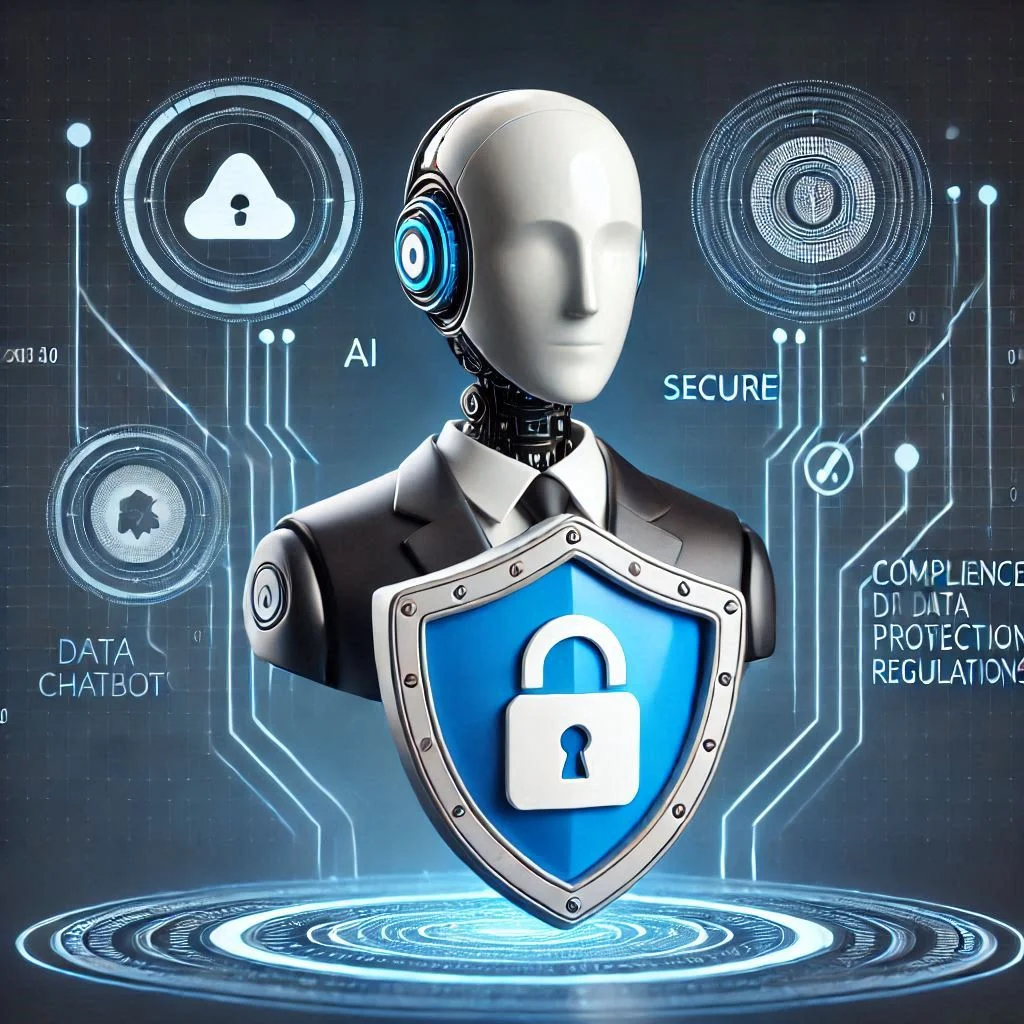
8. Monitor Performance
Use analytics tools to track your chatbot’s effectiveness. Metrics like user satisfaction, session duration, and conversion rates help optimize performance.
- Example: Adjust conversation scripts based on feedback to improve user engagement
9. Start Simple, Scale Gradually
Begin with basic functionalities and expand as you gain insights into user behavior and business needs. This approach minimizes risks and ensures smoother deployment.
10. Gather User Feedback
Encourage users to share their experience with the bot. Use this feedback to fine-tune its performance and address pain points.
- Example: Implement post-conversation surveys.
Testing, Launching, and Monitoring Your AI Bot
Testing Tools
Testing is essential to ensure your AI bot functions seamlessly across different scenarios. Use advanced testing tools and frameworks to validate performance, security, and user interactions.
1. Functional Testing
- Ensure the bot understands intents and provides accurate responses.
- Test various conversational flows, edge cases, and fallback mechanisms.
- Tools: Botium, TestMyBot, and Teneo.
2. Usability Testing
- Verify that the chatbot is user-friendly and intuitive.
- Test for response speed, error messages, and overall conversational tone.
3. Performance Testing
- Evaluate the bot’s ability to handle simultaneous queries and peak traffic.
- Tools: LoadRunner, JMeter, and Locust.
4. Security Testing
- Check for vulnerabilities in data transmission and storage.
- Implement SSL encryption, user authentication, and compliance checks.
5. Integration Testing
- Validate that the chatbot integrates smoothly with CRMs, payment systems, and other APIs.

Setting Up Greetings and Widgets
1. Personalized Greetings
The first impression matters. Design engaging welcome messages tailored to your audience.
- Examples:
- “Hi! How can I assist you today?”
- “Welcome to [Brand Name]! Let’s solve your query.”
2. Conversational Widgets
- Add interactive widgets to your website or app for easy chatbot access.
- Customize the appearance (color, text, icons) to match your brand identity.
- Position the widget strategically (e.g., bottom right corner).
3. Chat Handoffs
- Implement seamless transitions to human agents when needed.
- Include messages like: “I’ll connect you with an agent for further assistance.”
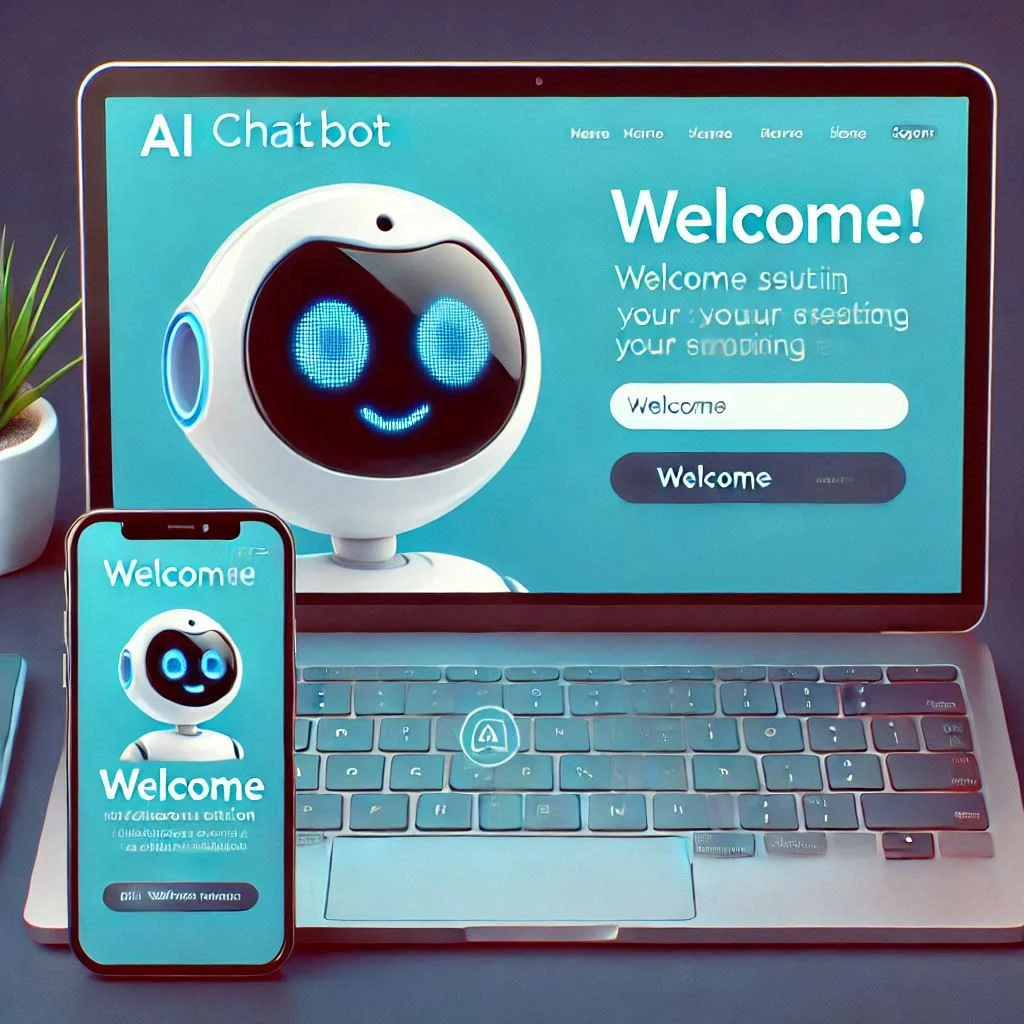
Validating and Publishing
Before going live, ensure your chatbot is polished and aligned with business goals.
1. Validation Steps
- Verify conversational flows align with user expectations.
- Conduct real-user testing with small focus groups to gather feedback.
- Check compliance with data protection laws like GDPR and CCPA.
2. Publishing Checklist
- Ensure the bot is accessible across all intended platforms (e.g., website, mobile app, social media).
- Load test servers to ensure scalability at launch.
- Double-check fallback and error handling mechanisms.
3. Launch Plan
- Roll out in stages:
- Phase 1: Soft launch with limited users.
- Phase 2: Full-scale launch based on insights from Phase 1.
- Announce the bot on social media, newsletters, and your website.
Monitoring Analytics and Feedback
Launching is only the beginning. Continuous monitoring and optimization are essential for long-term success.
1. Analytics Tools
- Track user interactions, retention rates, and completion of conversation goals.
- Tools: Google Analytics, Bot Analytics, and Dashbot.
2. Metrics to Monitor
- Engagement: Number of active users, session duration.
- Performance: Response time, error rates.
- Conversion Rates: How effectively the bot achieves its objectives (e.g., lead generation, sales).
3. User Feedback
- Encourage users to rate their experience post-chat.
- Act on feedback to improve responses, flow, and overall functionality.
4. Regular Updates
- Continuously train the bot with new intents and queries.
- Analyze emerging trends and incorporate new features accordingly.
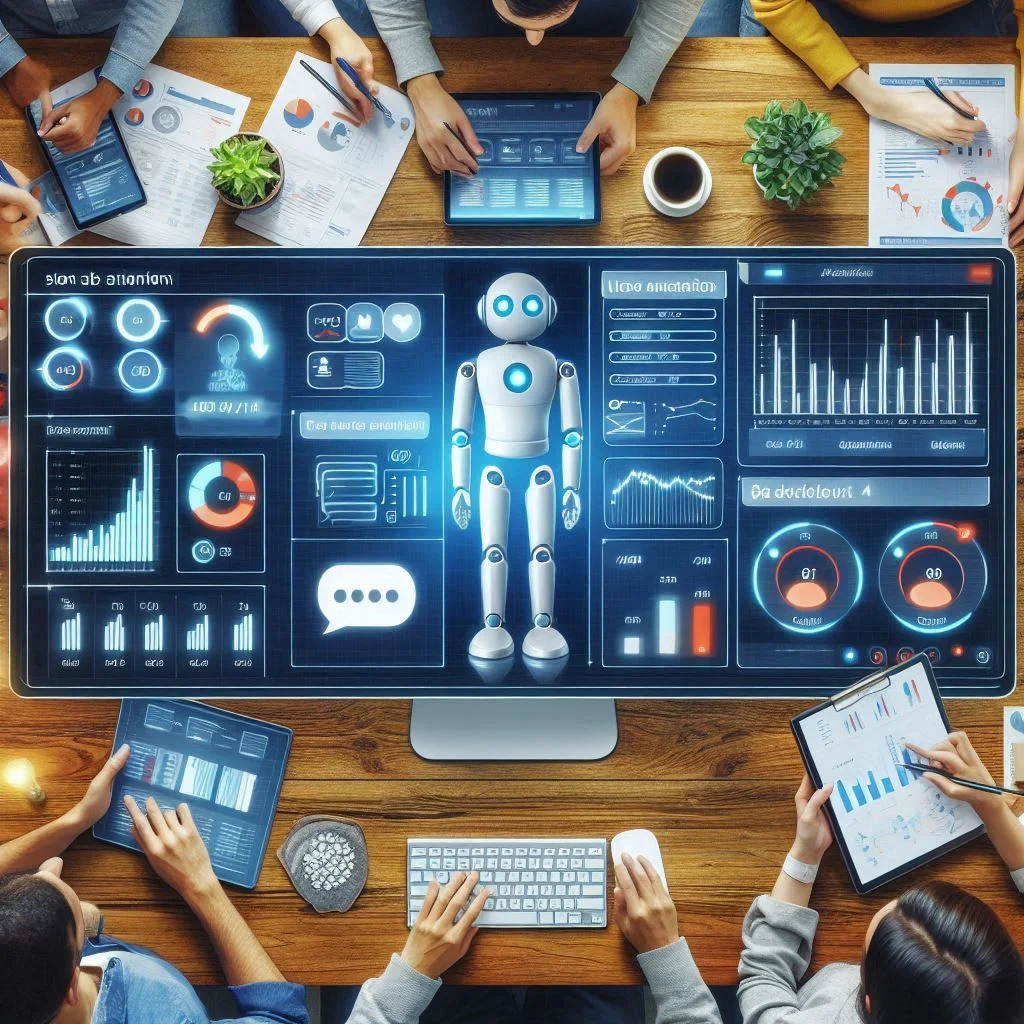
Why You Should Create an AI Bot for Your Website
AI bots enhance customer engagement, streamline processes, and provide scalable solutions.
- Advantages:
- 24/7 availability.
- Reduced operational costs.
- Improved customer satisfaction.
Conclusion
Building an AI bot can transform your business operations and customer engagement, offering seamless, efficient, and personalized interactions. From understanding the different types of AI chatbots to creating, testing, and refining your bot, each step is crucial for developing a tool that adds value and scales with your needs. While deciding between pre-built chatbot platforms and custom solutions involves weighing pros and cons, the right choice depends on your unique objectives and resources. By following the detailed steps outlined in this guide, you can successfully create an AI bot that enhances your customer experience, boosts efficiency, and drives long-term growth. Embrace the power of AI technology and stay ahead in the ever-evolving digital landscape.

